UNODC Scientific Consultation Vienna, 11 March 2014
“Science addressing drugs and HIV: State of the Art”
Read the comments section below for LEAHN specific responses to the ‘Consensus Statement’
A Consensus Statement (Access the PDF here)
Context
As the Commission on Narcotic Drugs (CND) conducts its high-level review of the implementation of the Political Declaration and Plan of Action, there remains a significant discrepancy between what science has shown actually works, and what in reality is being implemented in countries most affected by HIV and hepatitis C epidemics driven by unsafe injecting drug use.
It is estimated that, of the estimated 13 (9-22) million people who inject drugs worldwide, 13% are living with HIV and more than 60% live with the hepatitis C virus with large regional variation. As long as effective measures to reduce drug consumption and unsafe injection are not implemented, HIV and hepatitis C virus will continue to spread among people who inject drugs and ultimately to their partners and to society in general. The HIV/AIDS and hepatitis C epidemics as these relate to injecting drug use is of particular concern in Eastern Europe and central Asia and throughout the rest of the Asian region.
In its resolution 56/6 in 2013, the Commission on Narcotic Drugs requested United Nations Office on Drugs and Crime (UNODC) to implement, as appropriate, the joint WHO, UNODC and UNAIDS- recommended comprehensive package of services for people who inject drugs, also known as harm reduction services, which includes:
(a) Needle and syringe programs (NSP) that provide people who inject drugs with sterile injecting equipment and remove contaminated injection material from circulation;
(b) Opioid substitution therapy (OST), and other evidence-based drug dependence treatment. Opioid substitution therapy is the best researched and most effective form of treatment of opioid dependence; it is also highly effective to prevent HIV among people who inject drugs;
(c) HIV testing and counseling;
(d) Antiretroviral therapy (ART). Antiretroviral therapy is effective for people who inject drugs as for other patients when associated with appropriate support;
(e) Prevention and treatment of sexually transmitted infections;
(f) Condom programs for people who inject drugs and their sexual partners;
(g) Targeted information, education and communication for people who inject drugs and their sexual partners;
(h) Prevention, vaccination, diagnosis and treatment for viral hepatitis;
(i) Prevention, diagnosis and treatment of tuberculosis.
Recent studies indicate that that the combination of opioid substitution therapy and needle and syringe programs can significantly reduce injecting risk behavior, HIV and, to a lower degree, hepatitis C incidence. Needle and syringe programs, opioid substitution therapy and antiretroviral therapy have a synergistic impact on the reduction of HIV incidence at a population level.
The absence of an enabling legal and policy environment and supporting regulatory framework, continues to hamper effective implementation of these programs. In many countries of the world, the provision of these evidence-based UN-recommended HIV interventions for people who inject drugs remains very limited or even absent.
According to the Harm Reduction International’s Global State of Harm Reduction latest report, 97 countries and territories currently support a harm reduction approach, this support being explicit either in national policy documents in eighty-three countries, and/or through the implementation or tolerance of harm reduction interventions such as needle and syringe programs in eighty-six countries, or opioid substitution therapy in seventy-seven countries. Expansion of harm reduction programs has been slow and many of the new programs remain small-scale pilots. Based on the same report, opioid substitution therapy in prisons was available in only forty-one countries and needle and syringe programs in prisons in only ten countries. In most low- and middle-income countries coverage of harm reduction services remains by far insufficient to stabilize and reverse HIV and viral hepatitis epidemics among people who inject drugs.
Consensus statement
The following statement represents the current scientific evidence on prevention and treatment of HIV and hepatitis as it relates to injecting drug use.
1. There is unambiguous and compelling evidence that sharing of injecting equipment is strongly associated with the risk of acquiring HIV and hepatitis C and its ongoing spread. Criminalization of drug use, restrictive drug policies and aggressive law enforcement practices are key drivers of HIV and hepatitis C epidemics among people who inject drugs. Drug policies should fully integrate and prioritize both public and individual health in order to implement strategic and effective responses to improve health among people who inject drugs, their communities and the general population.
2. There is compelling evidence that needle and syringe programs (NSP) and opioid substitution therapy (OST) are effective in reducing sharing of injecting equipment and averting HIV infections. Together with antiretroviral therapy (ART), which is also highly likely to reduce HIV transmission among people who inject drugs, needle and syringe programs and opioid substitution therapy improve quality of life, decrease mortality and reduce drug dependency. There is also evidence that these harm reduction interventions reduce crime and public disorder, improve social functioning and provide a bridge to drug dependence treatment.
Harm reduction interventions are good value for money. There is compelling evidence of cost-effectiveness for each of the three interventions across all regions of the world, with average costs per HIV infection averted ranging from $100 to $1,000.
The coverage of harm reduction programs is currently too low across almost all regions to have impact on spread of new HIV and hepatitis C infections. Scaling up harm reduction programs is a worthwhile investment; not only do the community benefits of harm reduction programs exceed treatment costs, but they also have the potential to provide significant returns on investments for governments.
The large number of people who inject drugs who are incarcerated and the high HIV and hepatitis C prevalence among them, together with the absence of effective harm reduction services in prisons, hamper efforts to reduce HIV prevalence among people who inject drugs and in the community. We need to stop incarceration of people who use drugs for minor drug related offenses, including by referral to HIV and drug services in the community.
Laws and policies should be implemented to ensure that the rights of people in prisons and pre-trial detention, including people who inject drugs, to access equivalent health care are respected. Compulsory centers for drug users (CCDUs) currently operate in many countries. These centres are not only ineffective in reducing drug use but often times represent acts of abuse and torture. HIV prevention and treatment is not provided in these centers where a high proportion of the detainees are either HIV positive or are at very high risk for infection. The United Nations has repeatedly called for the closure of these centres.
Women who inject drugs often have higher rates of HIV than their male counterparts. Women who use drugs and sell sex are even more vulnerable to HIV. Harm reduction should be included in all interventions for sex workers and safer sex messages should be part of all harm reduction programs for women who inject drugs. Reproductive health services should be integrated with harm reduction services. Women who are sex partners of men who inject drugs but do not inject drugs themselves are vulnerable to HIV infection because of low condom use and intimate partner violence.
3. Laws and policies that undermine access to harm reduction are key drivers of HIV and hepatitis C risks among people who inject drugs. Laws that criminalize drug use and possession result in stigma and policy displacement, which in turn undermine support for harm reduction. In addition, law enforcement practices and especially unauthorized policing practices are a pervasive barrier to the implementation and effectiveness of harm reduction programs.
Laws facilitating needle and syringe programs and opioid substitution therapy are effective “structural” interventions to curb HIV and hepatitis C virus spread among people who inject drugs. There is an urgent need to re- align harm reduction and law enforcement approaches to support prevention and treatment of HIV and hepatitis C among people who inject drugs.
4. Hepatitis C is a rising cause of severe liver disease and premature death among people who inject drugs, and represents a growing public health, social and economic burden. Awareness of the hepatitis C infection among people who inject drugs is low although the infection is highly prevalent in this population. Hepatitis C virus testing is rarely available to people who inject drugs worldwide, and even less have access to treatment, despite the evidence that the infection is curable. Successful hepatitis C prevention strategies combine high coverage of harm reduction measures with hepatitis C treatment. There is an urgent need to integrate hepatitis C treatment services into harm reduction services to enhance treatment uptake and cure rates. Novel, well-tolerated, and efficacious hepatitis C treatment regimens now offer the opportunity to treat the majority of infected people who inject drugs.
———————————————————————————————————————————————————————-
This consensus statement was produced in the context of a scientific consultation entitled “Science addressing drugs and Health: State of the Art” organized by the United Nations Office on Drugs and Crime (UNODC) on 11 March 2014, preceding the high-level segment of the 57th session of the Commission on Narcotic Drugs (CND and) based on thematic papers developed by David Wilson, Steffanie Strathdee, Tasnim Azim, Kate Dolan, Adeeba Kamarulzaman, Philip Bruggmann, and their respective co-authors, under the overall guidance of the Co-Chair of the scientific consultation Michel Kazatchkine, United Nations Secretary General’s Special Envoy on HIV/AIDS for Eastern Europe and Central Asia and Monica Beg, Riku Lehtovuori and Fabienne Hariga of UNODC.
Access the PDF for the Consensus Statement


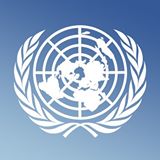

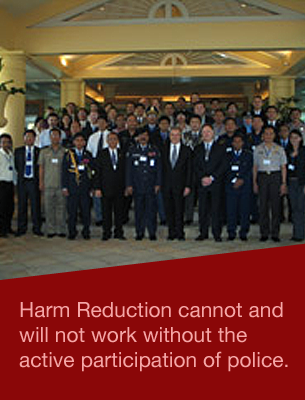
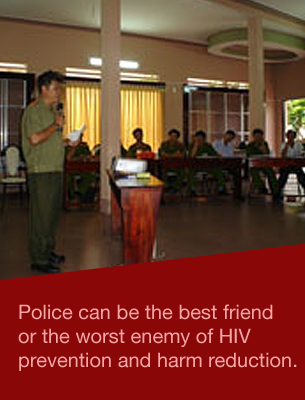
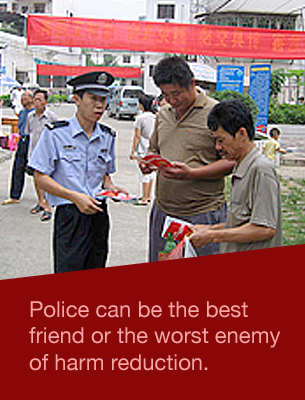
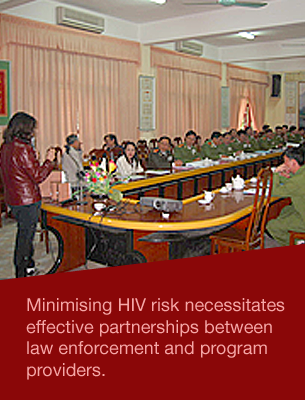
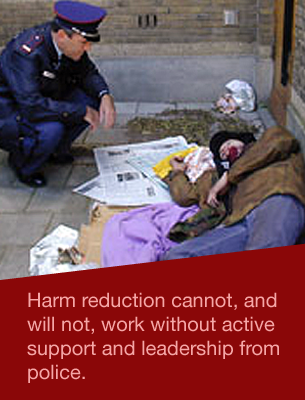


Congratulations to all involved in producing this Consensus Statement; I think it is great.
I am however disappointed that in canvassing the available evidence in relation to prevention of HIV among and from PWID, only evidence of the negative role of law enforcement was considered: “… law enforcement practices and especially unauthorized policing practices are a pervasive barrier to the implementation and effectiveness of harm reduction programs.”
While this is true and needs recognition and challenging, there is mounting and available evidence of the positive role law enforcement can play in the HIV response, in partnerships with civil society and with HIV programmes. It would have been good had this evidence been referred to in the Consensus Statement, as the basis for a call for more work with police to engage them effectively as critical partners in the HIV response.
For those who have not seen it, I attach the Statement of Support by police for harm reduction that has been produced by the Law Enforcement and HIV Network, has been signed by over 5,000 police officers worldwide and a number of police agencies (the most recent being the Seattle Police Department and the Dutch Police (Amsterdam)), and has been launched at the UN Crime Commission and at ICAAP2013, and will be launched again at AIDS2014.
It is time to start referring in such documents as the Consensus Statement to police and other law enforcement as partners, actual or potential, in the HIV response, not simply as barriers and obstacles.
Having said which – my congratulations again!
Nick Crofts
Director, LEAHN
I completely agree with Nick. ‘Positive law enforcement’ is a productive way to look at how best law enforcement agencies and personnel can help and become champions not only in promoting harm reduction but to provide a wider framework for support.
One example is the start up of district AIDS councils (DACs) we have initiated in Pakistan. These are chaired by the local government administration and co chaired by civil society/communities. The DPO – district police officer who is responsible for law enforcement in the district is an active member of the DAC.
The experience of DACs clearly shows that we too as advocates and lobbyists have been slow or reluctant to engage law enforcement persons – the resistance is not purely from their end. At least in the case of DACs: by showing evidence, by keeping in touch and by putting a ‘public health face’ rather than a ‘drug abuse or harm reduction face only’ to the work we do – there has been immense support from almost 100% of the DPOs. The CC’s (converted cops) worked on the RC’s (resistance cops) – and it works.
Examples of this support are: letters to all district police stations by the DPO not to harass but to support out reach workers; an even wider message that people using drugs need health care and treatment and not jails; a general reduction in police raids on people using drugs on the streets; fewer arrests and complaints from communities related to police harassment on the streets.
Positive focus would generate positive outcomes, hence like Nick said – lets focus on the positive outcomes of engaging with law enforcement.
On the other hand UNODC’s primary aim and major expense I believe is on supply reduction which entails law enforcement so maybe another UN agency or LEAHN with 5000 good cops should lead or at least provide direction. We do not need to re-invent the wheel.